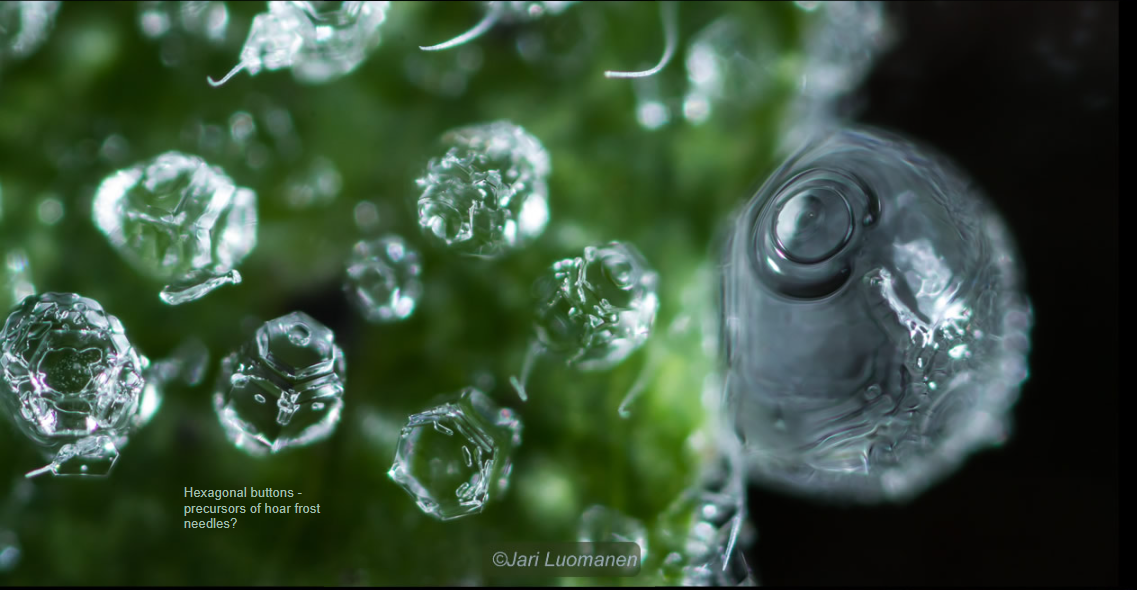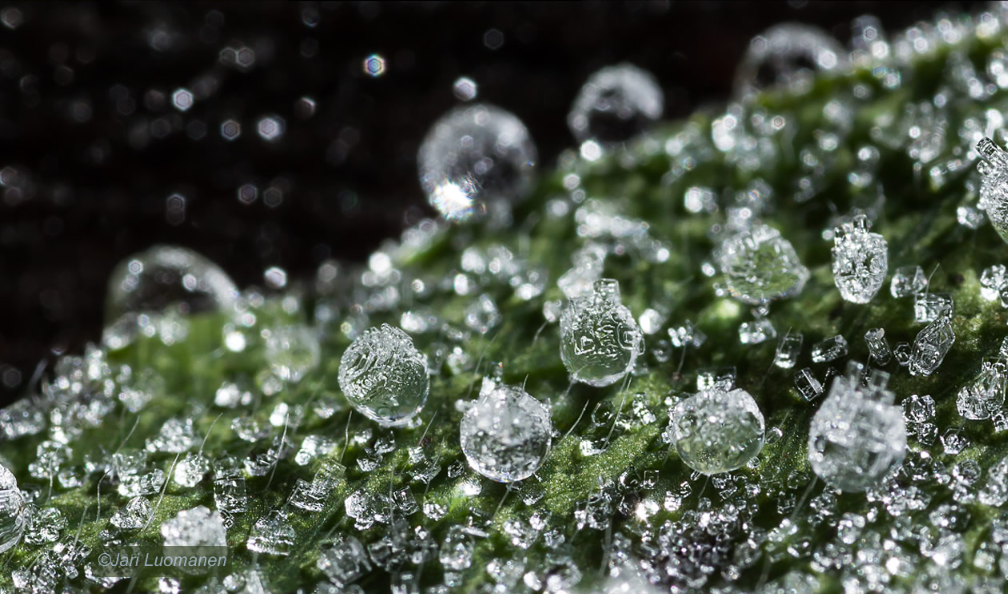Dew and Ice - OPOD
Dew and Ice - A Closer Look at a Fascinating Atmospheric Phenomenon
Have you ever wondered about the intricate details of frozen dewdrops and ice formations on leaves? These captivating images captured by Jari Luomanen give us a glimpse into the mesmerizing world of atmospheric optics. In this blog post, we will delve deeper into the subject of dew and ice, exploring the intriguing patterns and structures that emerge when water freezes in the natural environment.
When observing frozen dewdrops on leaves, it can be challenging to determine whether the drops are frozen throughout or if the ice is merely a surface film. However, even at the macro level, we can already discern the telltale signs of the nanoscale hexagonal structure characteristic of ice. Hexagonal protuberances can be seen forming on the surface of the frozen dewdrops, which may eventually develop into long columnar needles.
These hexagonal buttons serve as fascinating precursors to hoar frost needles, showcasing the initial stages of ice crystal growth. As the water molecules in the dewdrops freeze, they arrange themselves in a hexagonal lattice structure due to the unique bonding properties of H2O. This arrangement gives rise to the intricate and symmetrical patterns we observe in various forms of ice crystals.
To fully appreciate the beauty and complexity of these frozen formations, let's take a closer look at the images captured by Jari Luomanen. In one photograph, we see delicate icy structures resembling feathers or ferns delicately adorning a leaf's surface. Each individual ice crystal is a testament to the intricate dance of molecules and energy that occurs during the freezing process.
In another image, we are presented with a close-up view of frozen dewdrops on a leaf. Here, we can observe the hexagonal protuberances that have formed on the surface of the drops. These protuberances are a result of the water molecules aligning themselves in a hexagonal lattice as they freeze. Over time, these protuberances may grow into the long columnar needles we often associate with ice formations.
It is important to note that the images in this article have been automatically converted from the old website and may not appear exactly as intended. Nevertheless, they provide us with a captivating glimpse into the intricate world of atmospheric optics.
The study of dew and ice formations is not only visually appealing but also scientifically significant. Understanding the processes and structures involved in ice crystal growth can shed light on various atmospheric phenomena and contribute to our knowledge of weather patterns. By analyzing the intricate details of frozen dewdrops and ice formations, researchers can gain insights into the physical properties of water and the conditions necessary for the formation of different types of ice crystals.
In conclusion, the captivating images of frozen dewdrops and ice formations on leaves offer us a fascinating glimpse into the intricate world of atmospheric optics. The hexagonal protuberances and delicate structures we observe highlight the beauty and complexity of ice crystal growth. By studying these formations, scientists can deepen their understanding of weather patterns and gain insights into the physical properties of water. So next time you come across a frozen dewdrop or an icy leaf, take a moment to appreciate the wonders of nature's frozen artwork.

Icy Dew ~ Frozen dewdrops on leaves. Macro images by Jari Luomanen (atmospheric phenomena and sky).
Are the drops frozen through or is the ice is only a surface film? Hard to say. But already it is showing macro signs of its nanoscale hexagonal structure. Six sided protuberances have formed and might eventually grow into the long columnar needles of the previous OPOD.

Hexagonal buttons - precursors of hoar frost needles?


Note: this article has been automatically converted from the old site and may not appear as intended. You can find the original article here.
Reference Atmospheric Optics
If you use any of the definitions, information, or data presented on Atmospheric Optics, please copy the link or reference below to properly credit us as the reference source. Thank you!
-
<a href="https://atoptics.co.uk/blog/dew-and-ice-opod/">Dew and Ice - OPOD</a>
-
"Dew and Ice - OPOD". Atmospheric Optics. Accessed on November 26, 2024. https://atoptics.co.uk/blog/dew-and-ice-opod/.
-
"Dew and Ice - OPOD". Atmospheric Optics, https://atoptics.co.uk/blog/dew-and-ice-opod/. Accessed 26 November, 2024
-
Dew and Ice - OPOD. Atmospheric Optics. Retrieved from https://atoptics.co.uk/blog/dew-and-ice-opod/.